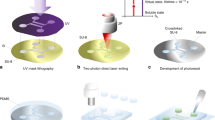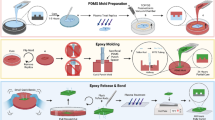Abstract
Microscopic fluidic devices, ranging from surgical endoscopes1 and microelectromechanical systems2 to the commercial ‘lab-on-a-chip’ (ref. 29), allow chemical analysis and synthesis on scales unimaginable a decade ago. These devices transport miniscule quantities of liquid along networked channels. Several techniques have been developed to control small-scale flow, including micromechanical3 and electrohydrodynamic4 pumping, electro-osmotic flow5, electrowetting6,7 and thermocapillary pumping8,9,10. Most of these schemes require micro-machining of interior channels and kilovolt sources to drive electrokinetic flow. Recent work8,9,10 has suggested the use of temperature instead of electric fields to derive droplet movement. Here we demonstrate a simple, alternative technique utilizing temperature gradients to direct microscopic flow on a selectively patterned surface (consisting of alternating stripes of bare and coated SiO2). The liquid is manipulated by simultaneously applying a shear stress at the air–liquid interface and a variable surface energy pattern at the liquid–solid interface. To further this technology, we provide a theoretical estimate of the smallest feature size attainable with this technique.
This is a preview of subscription content, access via your institution
Access options
Subscribe to this journal
Receive 51 print issues and online access
$199.00 per year
only $3.90 per issue
Buy this article
- Purchase on Springer Link
- Instant access to full article PDF
Prices may be subject to local taxes which are calculated during checkout



Similar content being viewed by others
References
Menz,W. & Guber,A. Microstructure technologies and their potential in medical applications. Min. Invasive Neurosurgery 37, 21–27 (1994).
Ho,C. H. & Tai,Y. C. Micro-electro-mechanical-systems (MEMS) and fluid flows. Annu. Rev. Fluid Mech. 30, 579–612 (1998).
van Lintel,H. T. G. A piezoelectric micropump based on micromachining of silicon. Sensors Actuators 15, 153–167 (1988).
Bart,S. F., Tarrow,L. S., Mehregany,M. & Lang,J. H. Microfabricated electrohydrodynamic pumps. Sensors Actuators A 21–23, 193–197 (1990).
Manz,A. et al. Electroosmotic pumping and electrophoretic separations for miniaturized chemical analysis systems. J. Micromech. Microeng. 4, 257–265 (1995).
Beni,G. & Tenan,M. A. Dynamics of electrowetting displays. J. Appl. Phys. 52, 6011–6015 (1981).
Gallardo,B. S. et al. Electrochemical principles for active control of liquids on submillimeter scales. Science 283, 57–89 (1999).
Handique,K., Gogoi,B. P., Burke,D. T., Mastrangelo,C. H. & Burns,M. A. Microfluidic flow control using selective hydrophobic patterning. Proc. SPIE 3224, 185–195 (1997).
Handique,K., Burke,D. T., Gogoi,B. P., Mastrangelo,C. H. & Burns,M. A. in Technical Digest: Solid State Sensor and Activator Workshop 346–349 (Transducer Research Foundation, Cleveland, Ohio, 1998).
Sammarco,T. S. & Burns,M. A. Thermocapillary pumping of discrete drops in microfabricated analysis devices. Am. Inst. Chem. Eng. J. 45, 350–366 (1999).
Ludviksson,V. & Lightfoot,E. N. The dynamics of thin liquid films in the presence of surface-tension gradients. Am. Inst. Chem. Eng. J. 17, 1166–1173 (1971).
Cazabat,A. M., Heslot,F., Troian,S. M. & Carles,P. Fingering instability of thin spreading films driven by temperature gradients. Nature 346, 824–826 (1990).
Brzoska,J. B., Brochard-Wyart,F. & Rondelez,F. Exponential growth of fingering instabilities of spreading films under horizontal thermal gradients. Europhys. Lett. 19, 97–102 (1992).
Kataoka,D. E. & Troian,S. M. A theoretical study of instabilities at the advancing front of thermally driven coating films. J. Colloid Interface Sci. 192, 350–362 (1997).
Kataoka,D. E. & Troian,S. M. Stabilizing the advancing front of thermally driven coating films. J. Colloid Interface Sci. 203, 335–344 (1998).
Kataoka,D. E. & Troian,S. M. The transient dynamics and structure of optimal excitations in thermally driven films. Phys. Fluids. (submitted).
Spaid,M. A. & Homsy,G. M. Stability of Newtonian and viscoelastic dynamic contact lines. Phys. Fluids 8, 460–478 (1996).
Huppert,H. E. Flow and instability of a viscous current down a slope. Nature 300, 427–429 (1982).
Silvi,N. & Dussan,E. B. On the rewetting of an inclined solid surface by a liquid. Phys. Fluids 28, 5–7 (1985).
Troian,S. M., Herbolzheimer,E., Safran,S. A. & Joanny,J. F. Fingering instabilities of driven spreading films. Europhys. Lett. 10, 25–30 (1989).
Jerrett,J. M. & deBruyn,J. R. Finger instability of a gravitationally driven contact line. Phys. Fluids A 4, 234–242 (1992).
deBruyn,J. R. Growth of fingers at a driven three phase contact line. Phys. Rev. A 46, R4500–R4503 (1992).
Melo,F., Joanny,J. F. & Fauve,S. Fingering instability of spinning drops. Phys. Rev. Lett. 63, 1958–1961 (1989).
Fraysse,N. & Homsy,G. M. An experimental study of rivulet instabilities in centrifugal spin coating of viscous Newtonian and non-Newtonian fluids. Phys. Fluids 6, 1491–1504 (1994).
Kataoka,D. E. The Spreading Behavior of Thermally Driven Liquid Films. Thesis, Princeton Univ. (1999).
Brzoska,J. B., Ben Azouz,I. & Rondelez,F. Silanization of solid substrates: a step toward reproducibility. Langmuir 10, 4367–4373 (1994).
Wasserman,S. R. et al. The structure of self-assembled monolayers of alkylsiloxanes on silicon: a comparison of results from ellipsometry and low-angle x-ray reflectivity. J. Am. Chem. Soc. 111, 5852–5861 (1989).
Dulcey,C. L. et al. Deep UV photochemistry of chemisorbed monolayers: patterned coplanar molecular assemblies. Science 252, 551–554 (1991).
Freemantle,M. Downsizing chemistry Chem. Eng. News 77(8), 27–36 (1999).
Acknowledgements
We thank G. D. Barriac for assisting with the photolithographic patterning of the silicon wafers. This work was supported by the National Science Foundation through a graduate fellowship (D.E.K.) and a CAREER award (S.M.T.).
Author information
Authors and Affiliations
Corresponding author
Rights and permissions
About this article
Cite this article
Kataoka, D., Troian, S. Patterning liquid flow on the microscopic scale. Nature 402, 794–797 (1999). https://doi.org/10.1038/45521
Received:
Accepted:
Issue Date:
DOI: https://doi.org/10.1038/45521
This article is cited by
-
Laser pattern-induced unidirectional lubricant flow for lubrication track replenishment
Friction (2022)
-
Mechanically tunable single-component soft polydimethylsiloxane (PDMS)-based robust and sticky superhydrophobic surfaces
Applied Physics A (2019)
-
Epitaxial single crystal surface patterning and study of physical and chemical environmental effects on crystal growth
Colloid and Polymer Science (2014)
-
Overview of microneedle system: a third generation transdermal drug delivery approach
Microsystem Technologies (2014)
-
Measuring the temperature of fluid in a micro-channel using thermochromic liquid crystals
Experiments in Fluids (2012)
Comments
By submitting a comment you agree to abide by our Terms and Community Guidelines. If you find something abusive or that does not comply with our terms or guidelines please flag it as inappropriate.



